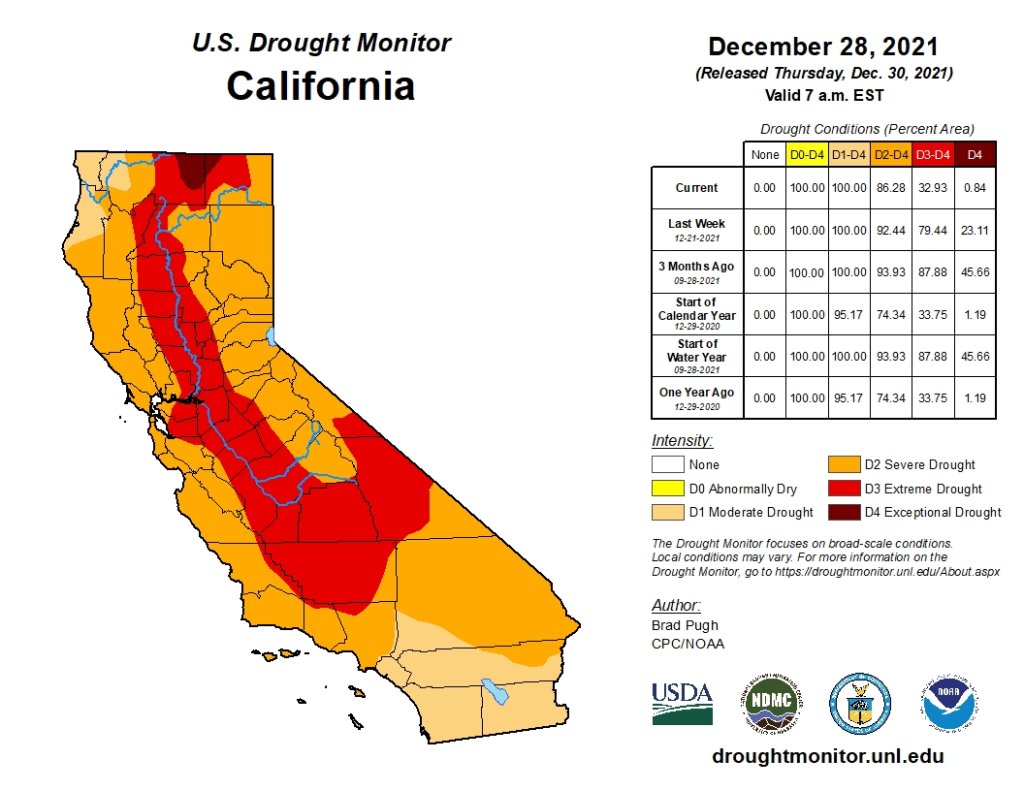A series of early winter storms that brought days of rain and snow to California helped improve conditions in the drought-stricken state.
All of California remains is some level of drought this week, but conditions improved significantly in the two most severe categories.
The weekly report released Thursday shows exceptional drought was nearly erased after 23 percent of the state was under the most severe category one week ago. Nearly 33 percent of the state is in extreme drought, down from 79 percent last week.
Three months ago, that figure was at 88 percent.

The US Drought Monitor map for the last week of 2021.
The storms fueled by a band of moisture over the Pacific began the week of Christmas and continued to usher in rain and mountain snow this week. The report was updated early Dec. 28, so it does not factor in all precipitation received this week.
“A persistent pattern over the North Pacific and western North America maintained a continuation of frequent storms affecting the West Coast through late December,” the Drought Monitor statement said. “Seven-day precipitation from December 21-27 exceeded 2 inches, liquid equivalent, across much of California along with western portions of Oregon and Washington.

US Drought Monitor These maps show drought conditions according to the US Drought Monitor reports released Dec. 30 (right) and the previous week.
During the past two weeks, precipitation has averaged 150 to 300 percent of normal or more throughout nearly all of California, the report stated.
“This wet pattern during mid to late December has also been accompanied by below normal temperatures (-2 to -6 degrees F) across California and the Pacific Northwest.”
The Central Sierra snow lab has observed 193.7 inches of snowfall this month, which is a December record, topping the previous record of 179 inches set in 1970.
“Given the favorable snowpack and heavy precipitation during December, additional improvements may be warranted for California during subsequent weeks,” the Drought Monitor report said.
Droughts are common in California, where dry spells are often followed by wet winters that replenish the state’s critical snowpack and water reservoirs, but conditions this year are hotter and drier than others.
So it’s going to take more than a lot of rain and snow to ease drought conditions.
Hot and dry conditions means water evaporates at a faster rate from reservoirs and the sparse Sierra Nevada snowpack that feeds them. The snowpack usually melts in spring or early summer, then that water flows into the state’s vast storage and distribution system.
California has more than 500 reservoirs, which were 50% lower than they should be at the start of June.
These photos show the dramatic impact of the current dry spell at California’s lakes and reservoirs.
California’s Mediterranean-style climate means the summers are always dry and the winters are not always wet. The state’s reservoirs act as a savings account, storing water in the wet years to help the state survive during the dry ones.
Last year was the third driest on record in terms of precipitation.
State officials were surprised earlier this year when about 500,000 acre feet of water they were expecting to flow into reservoirs never showed up. One acre-foot is enough water to supply up to two households for one year.
About three-quarters of the American West is in what is called a megadrought, with critical waterways like the Colorado River and Rio Grande that supply millions of people and farms expected to have dismally low flows this year.
